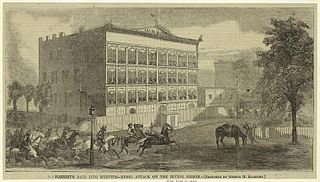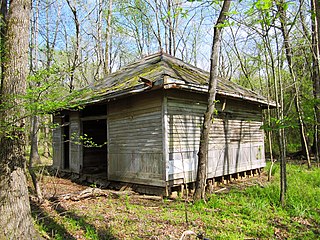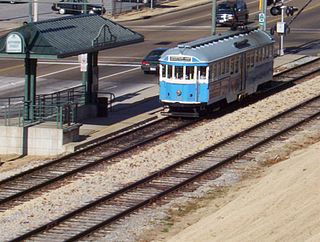
Memphis is a city in the U.S. state of Tennessee. It is the county seat of Shelby County, in the southwesternmost part of the state, and is situated along the Mississippi River. With a population of 633,104 at the 2020 U.S. census, Memphis is the second-most populous city in Tennessee after Nashville.

DeSoto County is a county located on the northwestern border of the U.S. state of Mississippi. As of the 2020 census, the population was 185,314, making it the third-most populous county in Mississippi. Its county seat is Hernando. DeSoto County is part of the Memphis metropolitan area. It is the second-most populous county in that statistical area. The county has lowland areas that were developed in the 19th century for cotton plantations, and hill country in the eastern part of the county.

Olive Branch is the sixth most populous city in Mississippi, US, located in DeSoto County. At the 2020 census the population was 39,711. Olive Branch is part of the Memphis Metropolitan Statistical Area, a region that consists of three counties in southwest Tennessee, five counties in northwest Mississippi, and two counties in eastern Arkansas. Along with other rapidly growing places in DeSoto County, Olive Branch attributes most of its growth and development to the exodus of large numbers of families from central Memphis.

West Tennessee is one of the three Grand Divisions of Tennessee that roughly comprises the western quarter of the state. The region includes 21 counties between the Tennessee and Mississippi rivers, delineated by state law. Its geography consists primarily of flat lands with rich soil and vast floodplain areas of the Mississippi River. Of the three regions, West Tennessee is the most sharply defined geographically, and is the lowest-lying. It is both the least populous and smallest, in land area, of the three Grand Divisions. Its largest city is Memphis, the state's second most populous city.

The Second Battle of Memphis was a battle of the American Civil War occurring on August 21, 1864, in Shelby County, Tennessee.
The Memphis Xplorers were a professional arena football team. They were a 2001 expansion member of the af2. They played their home games at DeSoto Civic Center in Southaven, Mississippi. The team's logo featured the likeness of the namesake of both the venue and the team, Spanish explorer Hernando de Soto.
Uptown Memphis is a neighborhood located near downtown Memphis, Tennessee. In 1999, the Uptown Partnership renamed the historic North Memphis Greenlaw neighborhood "Uptown" in concert with a public-private revitalization effort that defined Uptown as one hundred city blocks east of the Wolf River and North of A.W. Willis Avenue. The historic Greenlaw section of this neighborhood consists of the thirty city blocks closest to the Wolf River.

The Hernando de Soto Bridge is a tied-arch bridge carrying Interstate 40 across the Mississippi River between West Memphis, Arkansas, and Memphis, Tennessee. The design is a continuous cantilevered cable-stayed steel through arch, with bedstead endposts. Memphians also call the bridge the "New Bridge", as it is newer than the Memphis & Arkansas Bridge downstream, and the "M Bridge", due to its distinctive shape. It is of similar construction to the Sherman Minton Bridge between Louisville, Kentucky, and New Albany, Indiana.

Don Manuel Luis Gayoso de Lemos y Amorín was the governor of Spanish Louisiana from 1797 until his death in 1799.

The Peabody Memphis is a historic luxury hotel in Downtown Memphis, Tennessee, opened in 1925. The hotel is known for the "Peabody Ducks" that live on the hotel rooftop and make daily treks to the lobby. The Peabody is a member of Historic Hotels of America, a program of the National Trust for Historic Preservation.

The Yazoo and Mississippi Valley Railroad (Y&MV) was incorporated in 1882 and was part of the Illinois Central Railroad system (IC). Construction began in Jackson, Mississippi, and continued to Yazoo City, Mississippi. The line was later expanded through the Mississippi Delta and on to Memphis, Tennessee. In 1886, the IC purchased the Mississippi and Tennessee Railroad. In 1892, the IC bought the Memphis to New Orleans line, forming the Louisville, New Orleans and Texas Railway. These lines were merged into the Y&MV. Main lines included Memphis to New Orleans via Vicksburg and Baton Rouge, Memphis to Tutwiler, Clarksdale, MS to Yazoo City, Clarksdale to Jackson, MS, and Jackson to Natchez.

The history of Memphis, Tennessee and its area began many thousands of years ago with succeeding cultures of indigenous peoples. In the first millennium, it was settled by the Mississippian culture. The Chickasaw Indian tribe emerged about the 17th century, or migrated into the area. The earliest European exploration may have encountered remnants of the Mississippian culture by Spanish explorer Hernando de Soto. Later French explorers led by René-Robert Cavelier, Sieur de La Salle likely encountered the Chickasaw. The city of Memphis was not founded until 1819. The city was named after the ancient capital of Egypt on the Nile River in North Africa.

Memphis, Tennessee has developed into a major Mid-American commercial and transportation hub because of its location on the Mississippi River and a convergence of numerous rail and highway links. Four rail and highway bridges cross the Mississippi River at Memphis. In addition, Memphis International Airport has become the world's largest airfreight terminal.

The Belz Museum of Asian and Judaic Art is located at 119 South Main Street at the intersection of Gayoso Avenue in Memphis, Tennessee, USA. The museum was opened in 1998 as the Peabody Place Museum and in January 2007 it received its present name.

The Pinch District is a historical district of downtown Memphis roughly bordered by the Wolf River lagoon on the west, Market Street on the south, Danny Thomas Boulevard on the east, and A.W. Willis Avenue on the north.
Tanger Outlets Southaven is an outlet mall in Southaven, Mississippi, just outside Memphis, Tennessee. The mall, located at the intersection of I-55/I-69 and Church Road, began construction in January 2015 and opened in November 2015. Tanger Outlets Southaven is the first outlet mall in the Memphis metro area.

The Nineteenth Century Club is a historic philanthropic and cultural women's club based in Memphis, Tennessee. The Nineteenth Century Club adopted the idea that the community was an extended "household" that would benefit from the "gentler spirit" and "uplifting influence" of women, and shifted towards civic reform. The club primarily focused on the needs of women and children, addressing public problems such as sanitation, health, education, employment, and labor conditions.

Charles Oscar Pfeil was an American architect and golfer, primarily based in Memphis, Tennessee (USA), during the first third of the twentieth century. He formed the prominent Memphis architectural firm Pfeil and Awsumb with his colleague George Awsumb between 1919 and his death.
Newton Alonzo Wells was an American artist and professor of art. Wells is known for his portrait paintings, murals, etchings, and sculptures; as well as decorative art. He was a professor emeritus at the University of Illinois Urbana-Champaign (UIUC).
Puss Pettus was a 19th-century American prostitute. She was a successful business owner in Tennessee, best known for running a brothel in Memphis during the American Civil War.















